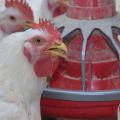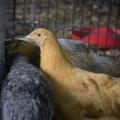Sexing of day-old chicks
Sexing day-old chicks can be accomplished by one of two methods: 1) vent sexing or 2) feather sexing. Each method has difficulties that make it unsuitable for use by the small flock owner. Vent sexing relys on the visual identification of sex based on appearance of sexual organs. Feather sexing is based on differences in feather characteristics at hatch time. A brief explanation of each method is as follows.
Vent sexing of chicks at hatching has complications that make it more difficult than sex determination of most other animals. The reason is that the sexual organs of birds are located within the body and are not easily distinguishable. The copulatory organ of chickens can be identified as male or female by shape, but there are over fifteen different different shapes to consider. Therefore, few people have experience with determining the sex of birds because of the difficult nature of the process. Most of these highly trained individuals are employed by large commercial hatcheries. The training to be a chick sexer is so difficult and lengthy that the average poultry owner finds it unjustifiable.
Feather sexing is based on feather characteristics that differ between male and female chicks. The method is very easy to learn by the poultryman, but the feather appearances are determined by specially selected genetic traits that must be present in the chick strain. Most strains (breeds) of chickens do not have these feather sexing characteristics and feathering of both sexes appear identical.
The most convenient method of sexing chickens by the small flock owner is to care for the birds until they begin showing the natural secondary characteristics of their sex. In males, the combs and wattles will become larger than those on females and the head will become more angular and masculine looking. The female will remain smaller than the male and is more refined or feminine looking. In some varieties the feathers of each sex will develop a characteristic color pattern that identifies it. These varieties of birds are similar to the feather-sex strains of chickens discussed above. Sexing based on secondary sex characteristics can usually be performed after chicks attain 4 to 6 weeks of age.
Publications
News
STARKVILLE, Miss. -- Until an avian flu vaccine for chickens or other alternative is federally approved, commercial poultry operations in the U.S.
STARKVILLE, Miss. -- If egg prices have seemed higher than ever lately, it’s because they are, and consumers can place much of the blame squarely at the feet of the ongoing bird flu outbreak.
With highly pathogenic avian influenza, or HPAI, in the environment in Mississippi, owners of backyard flocks have to take extra steps to keep their chickens healthy.
Avian influenza poses an extremely low risk to human health and none to food safety in Mississippi, but its presence poses a risk to backyard flocks and the state’s $3 billion commercial poultry industry.







